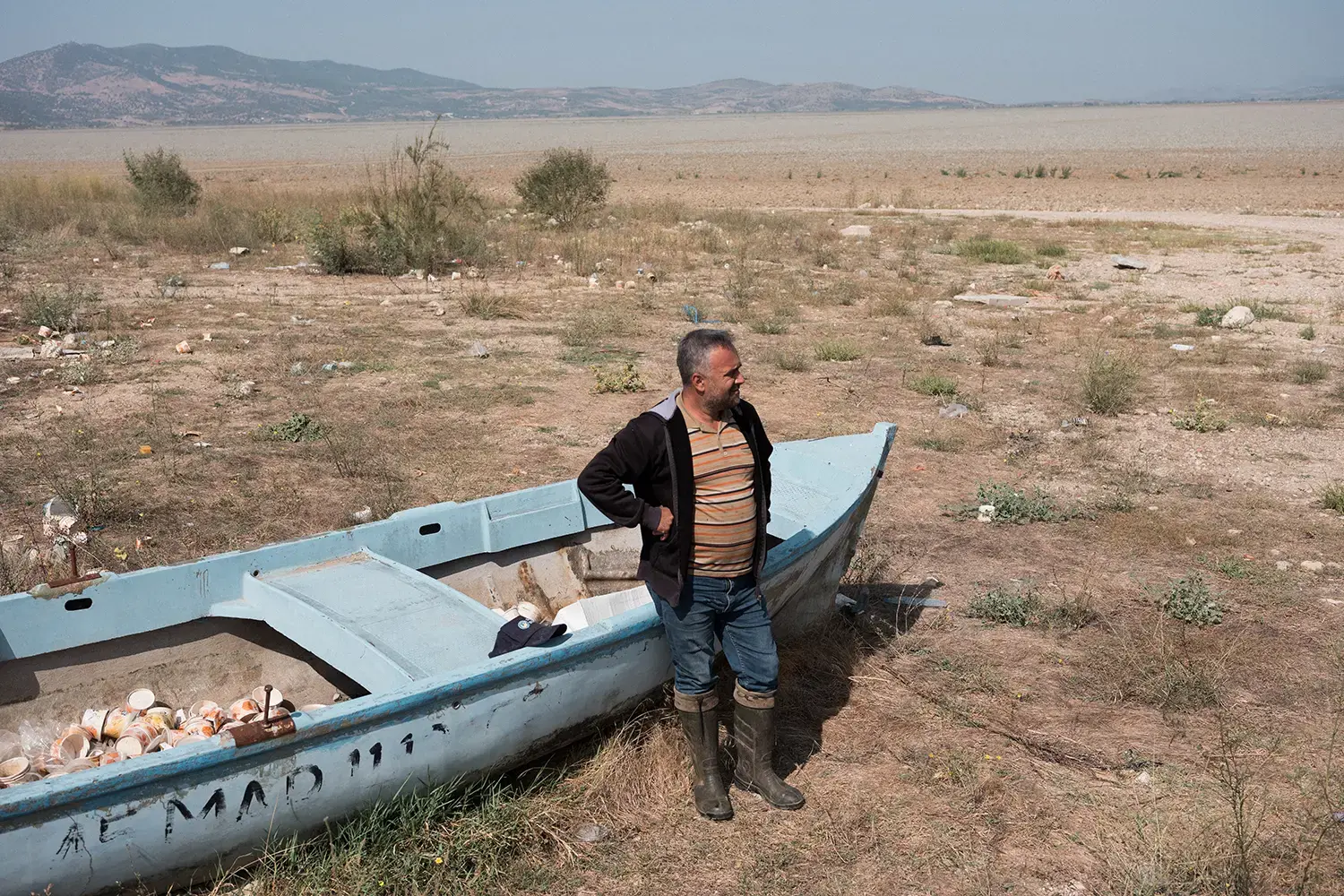
Turkish President Erdogan’s mega-infrastructure projects are enriching construction companies while reshaping his country’s waterscape for the worse.
TEKELIOGLU, Turkey—On a humid midsummer morning, the fishermen of Tekelioglu, a village in western Turkey, gathered to talk about how their lake disappeared. The decline began a decade ago, they agreed, after a nearby dam on the Gordes River was completed in 2009. A few years later, temperatures rose, the winter rains stopped falling, and in 2021, the lake dried up entirely.
Marmara Lake once spanned 17 square miles. It supported hundreds of livelihoods and thousands of migratory birds: “A bird paradise,” the fishermen said.
Now, it’s like it never existed. The fish died. The birds changed their paths. The tortoises that lived around the lake started wandering into nearby gardens and homes in search of water. Today, a few rotting fishing boats lay abandoned on what used to be the lake’s shore. A fig tree has sprouted on the southern shore of the dry bed.

As a nonprofit journalism organization, we depend on your support to fund more than 170 reporting projects every year on critical global and local issues. Donate any amount today to become a Pulitzer Center Champion and receive exclusive benefits!
The Gordes Dam is one of hundreds built during Turkish President Recep Tayyip Erdogan’s 20 years in power, intended to provide water for drinking, irrigation, and notably, electricity generation. About 20 percent of Turkey’s power comes from hydroelectricity—its biggest renewable source by far—making it a major driver of the country’s dam-building push.
In pursuit of these ends, however, dams have remolded Turkey’s waterscape entirely: Villages and cultural sites have been flooded, while lakes and rivers are parched. Some dams, such as Gordes, are malfunctioning only a few years after being completed. The companies that built them—many of which have strong ties to Erdogan—continue to reap huge profits in spite of their failures, wreaking catastrophic damage on the environment, destroying livelihoods, and exacerbating Turkey’s water crisis in the process.

During times of antiquity, the Aegean region of western Turkey was part of the well-watered Fertile Crescent. Today, the region is overheated and overdeveloped, marred by a vicious cycle of forest fires and drought. The population of Izmir, the region’s major city, has swelled from 1.2 million in 1980 to 3 million today, placing huge demands on its water supply. The Gordes Dam was meant to solve this scarcity. Some 60 percent of the dam’s supply was to be pumped to Izmir, and the remaining 40 percent would be used to irrigate 150,000 hectares (about 580 square miles) of surrounding farmland, where peaches, grapes, and walnuts are cultivated.
But these promises never materialized.
In 2022, Tunc Soyer, Izmir’s mayor and a prominent member of the opposition to Erdogan, called the project a “fiasco.” The city was paying for the Gordes Dam’s water, he said, but had still not received a drop.
Construction on the dam began in 1998 after a $170 million contract was awarded to Kocoglu Construction. It took more than a decade to build, but after opening in 2009, it started losing water immediately. Cracks had formed across the base of its 5.5 million cubic meter (about 1.5 billion gallon) reservoir and in the tunnel that carried the water to its destinations; even after being drained and repaired in 2015, the reservoir continued to leak.
The dam’s reservoir has not been more than 7 percent full since 2020. State officials claim that the repairs have worked, and that droughts, not leaks, are causing the low levels. But data from Izmir’s water authority shows that levels in the five other reservoirs in the region rose between 2020 and 2022 as Gordes’s level fell. All have been afflicted by low rainfall this year, but Gordes’s current level, 6.83 percent of its full capacity, is far below the average of the others, 35.67 percent.
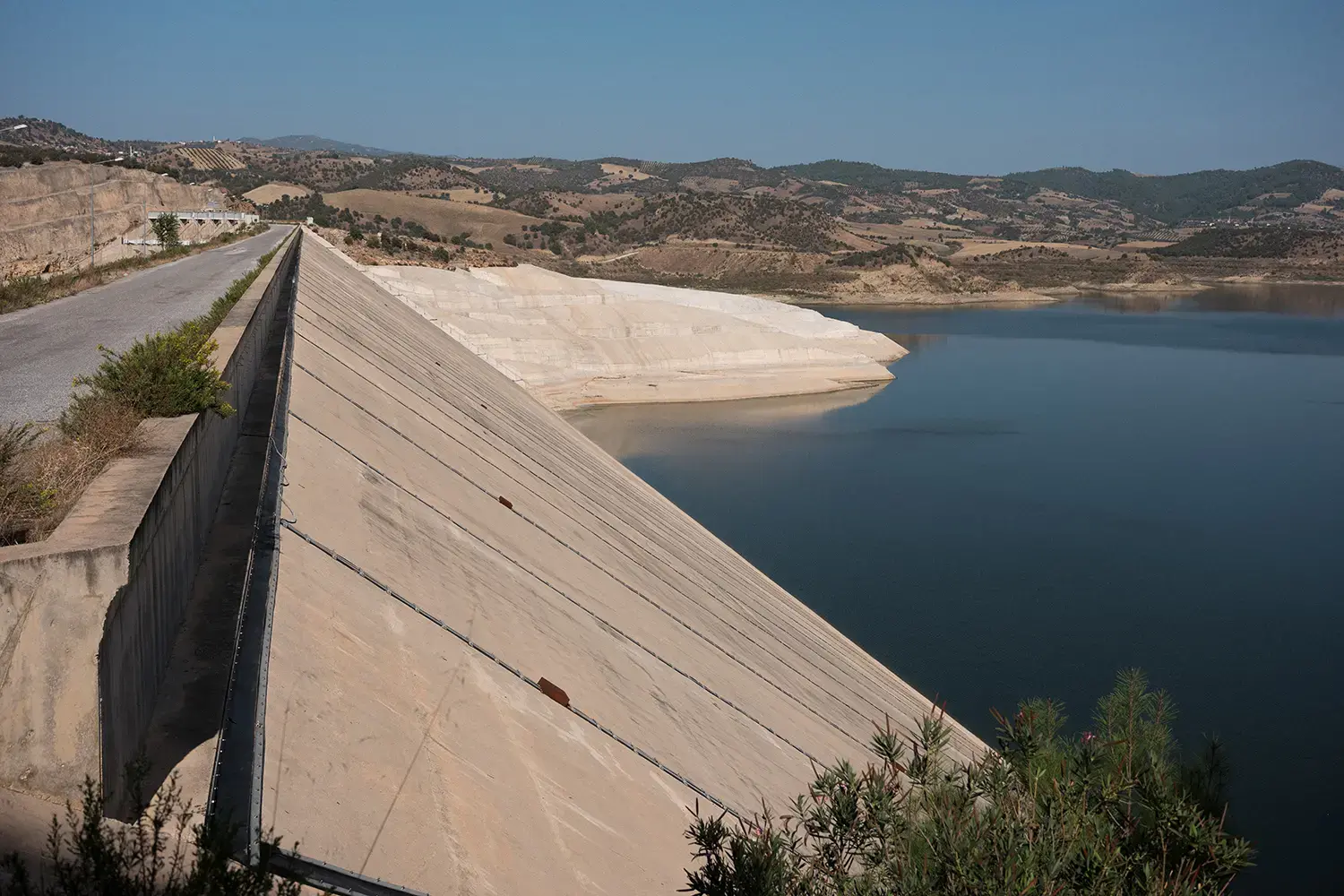
In 2021, the former regional head of the state water agency, Hasan Baykal, offered testimony about the project, saying that surveys carried out prior to construction had shown that the ground was not suitable for the type of dam that was built. Because the ground is made of porous limestone, water would simply drain away unless the bed of the dam was covered in concrete. Yet once the tender was issued and construction underway, the vital concrete base was left out in order to cut costs. To date, there has been no investigation nor official response to Baykal’s claims.
Unfortunately, in Turkey, this type of mismanagement is an all-too-familiar story.
Erdogan has long used construction as a tool for channeling money to his political allies. During his tenure as mayor of Istanbul in the 1990s, he oversaw a warp-speed redevelopment and expansion of the city, with entire districts built from scratch. When he took office as prime minister in 2003, he and his Justice and Development Party (AKP) promised to modernize Turkey and change its culture of rampant corruption. As part of this modernization push, he accelerated construction across all sectors—including dam building—but instead of curbing corruption, he just put his own stamp on the problem.
The consequences of this infrastructure kleptocracy were put on full display earlier this year, when Turkey experienced a devastating earthquake—made even deadlier and more destructive by constructors’ and regulators’ repeated disregard for safety regulations.
Now, this kleptocracy is wreaking havoc on Turkey’s water infrastructure.
A Vanished Lake
Satellite images show Marmara Lake in 2016 (left) compared with the dry landscape in 2023. Images from Copernicus Sentinel-2 via Maxar Technlogies.
The most famous example of this is the Ilisu Dam, located on the Tigris River in Turkey’s predominantly Kurdish southeast region. Hailed as a major driver of development in the poorest part of the country, plans for the dam had been touted since the 1950s but were repeatedly canceled or postponed due to concerns over the devastation it could wreak on its surroundings. In 2001, the Council of Europe urged Turkey to find an alternative to the dam, and an international construction consortium pulled out of the project. Work restarted in 2007 but stalled again when foreign lenders pulled out of construction on the grounds that the dam did not meet the World Bank’s environmental and heritage standards.
After international constructors backed out, Ilisu was contracted to a consortium of three Turkish companies: Nurol, Cengiz, and Celikler, all of which have won numerous lucrative state contracts and are headed by businessmen who have personal ties to Erdogan or have praised him publicly. When Ilisu was finally completed in 2018, water started backing up against the dam, causing river levels to rise.
It wasn’t long before the ancient cave city of Hasankeyf, located 25 miles northwest, was underwater. The flooding destroyed churches, mosques, and tombs of 10,000-year-old civilizations, dislocating some 80,000 people in the process. A local activist group described the submersion as an “apocalypse.”
Kocoglu Construction, the company that built the Gordes Dam, also has ties to Erdogan. Its director, Sukru Kocoglu, was the head of Turkey’s politically influential Construction Industry Employers’ Union when Erdogan rose to national power. After winning and completing the Gordes Dam contract, Kocoglu became an outspoken backer of Erdogan and his infrastructure megaprojects.
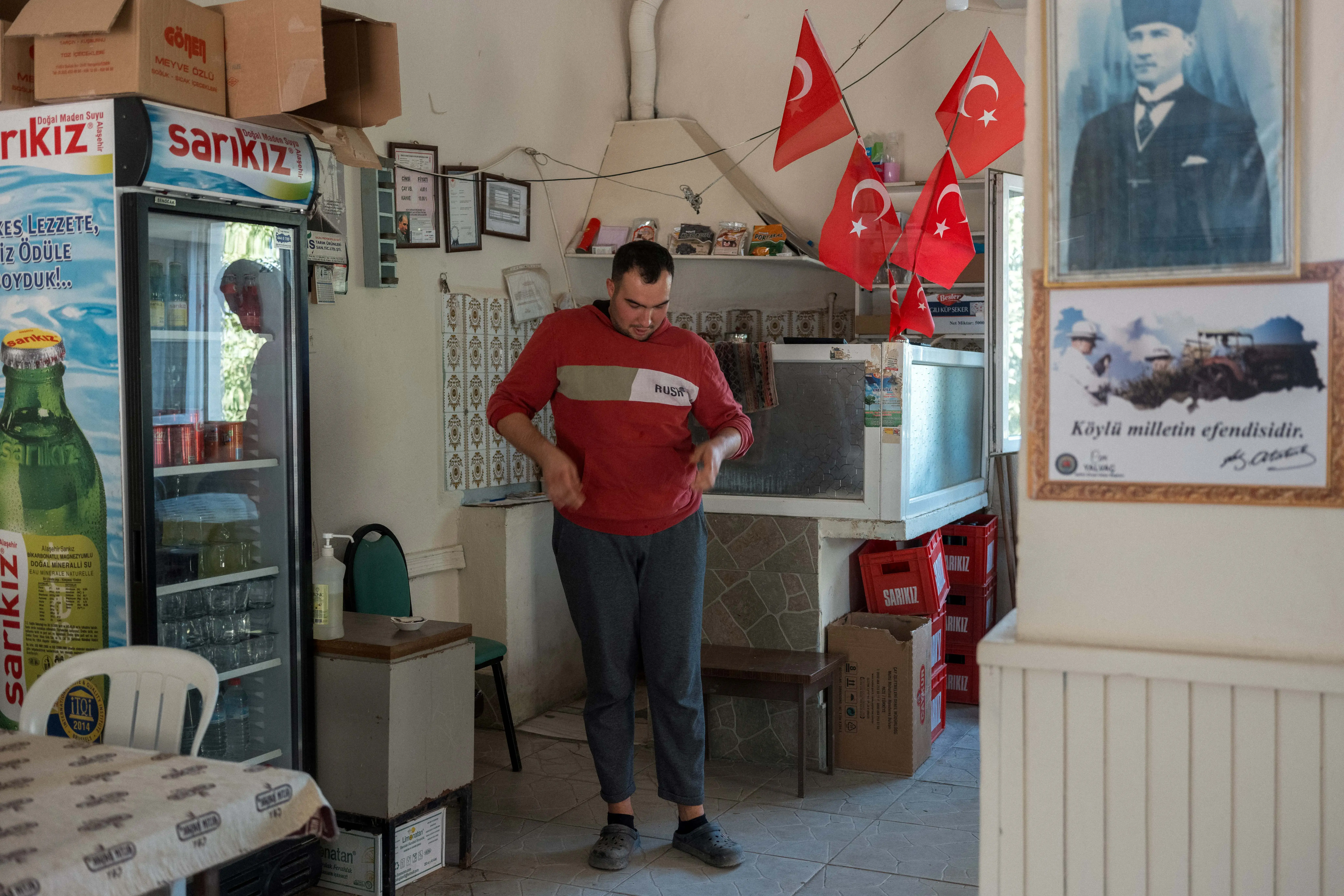
In 2011, he praised Erdogan’s “crazy project”—a $15 billion plan to build a new shipping canal through Istanbul, widely criticized for its potential environmental and economic consequences—on the grounds that it would bring huge profits for constructors. That same year, Kocoglu hailed Erdogan’s latest election win and controversial changes to Turkey’s constitution, which, by abolishing the office of the prime minister and ushering in an executive presidency, amounted to a major power grab by Erdogan.
His political loyalty appears to have paid off. Even after the faulty construction of the Gordes Dam, Kocoglu received two additional contracts for large public-private partnership projects: Turkey’s second biggest airport, located in the Mediterranean province of Mersin, and a road tunnel from Izmir to nearby Manisa.
Despite the contracts pouring in, however, Kocoglu Construction was unable to insulate itself from financial trouble, and in 2014, it collapsed under a mountain of debt. Workers downed tools on the half-finished tunnel and airport. The tunnel contract was transferred to Kalyon Construction—which, as it happens, is majority-owned by Calik Holding, the CEO of which was Erdogan’s son-in-law, Berat Albayrak, until 2013—along with $68 million in extra funding to finish the job.
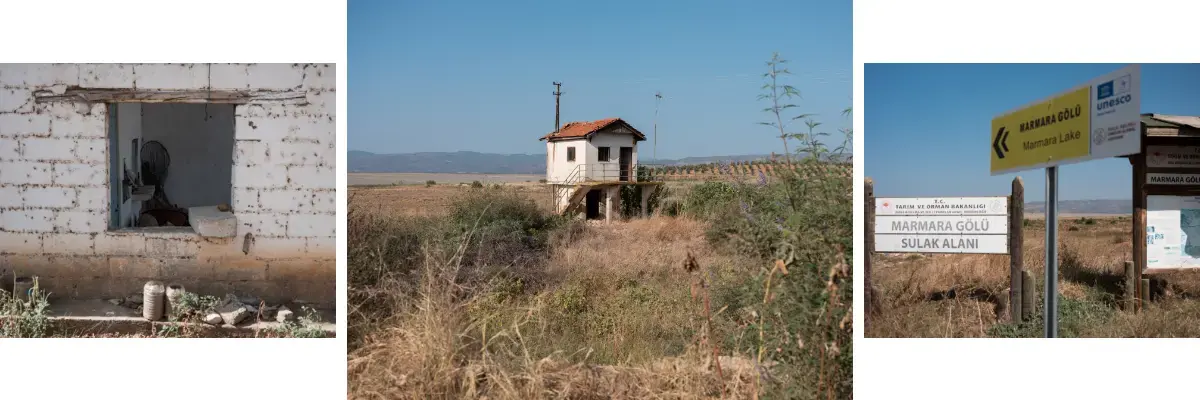
While Turkey’s constructors profit from the dams, locals are suffering. About 15 miles downstream from the Gordes Dam, Marmara Lake is now starved of its lifeblood. In May, the local governate rezoned the area, allowing it to be cultivated. The state agricultural agency sent workers to plant wheat where the lake once stood, effectively rubber-stamping its disappearance. But the town of Tekelioglu owes its existence to the lake. Four in five men here worked as fishermen, catching 100 tons of carp, eel, and crayfish each year. Tourists used to come here, too: Marmara was the only lake in the region, providing a cool relief in an otherwise dusty basin. The village restaurant still advertises fresh-catch seafood, even though there is now none to be found.
“It gave us oxygen,” said Burhan Cetin, one of the fishermen. “Now [that] it has gone, it has affected all of us psychologically. Only Allah knows what will happen—there is nothing that we can do. We can’t even sell our equipment.”
The state will profit from the wheat and sunflowers now growing on Marmara Lake’s bed, but the fishermen who relied on the lake will not see a penny. The forestry authorities continued to charge them for their fishing licenses—even after the lake had dried up—until several successfully won a legal case against the state in August 2022.
The fishers have since opened a second case against the State Hydraulic Works agency for its mismanagement of the dam and the local governate for rezoning the lake without conducting an environmental assessment, even though it was officially classified as a protected wetlands area. The case aims to force the Turkish state to try to rehabilitate the lake. Sener Kilimcigoldelioglu, who heads a local ecological association, insists that Marmara Lake can be revived by rerouting streams from the nearby Bozdag Mountains.
Others are more pessimistic: “The only solution is for the dam to be demolished,” said Rafet Kerse, another fisherman, so that the Gordes River can flow to the lake again. “Nothing else will work.”
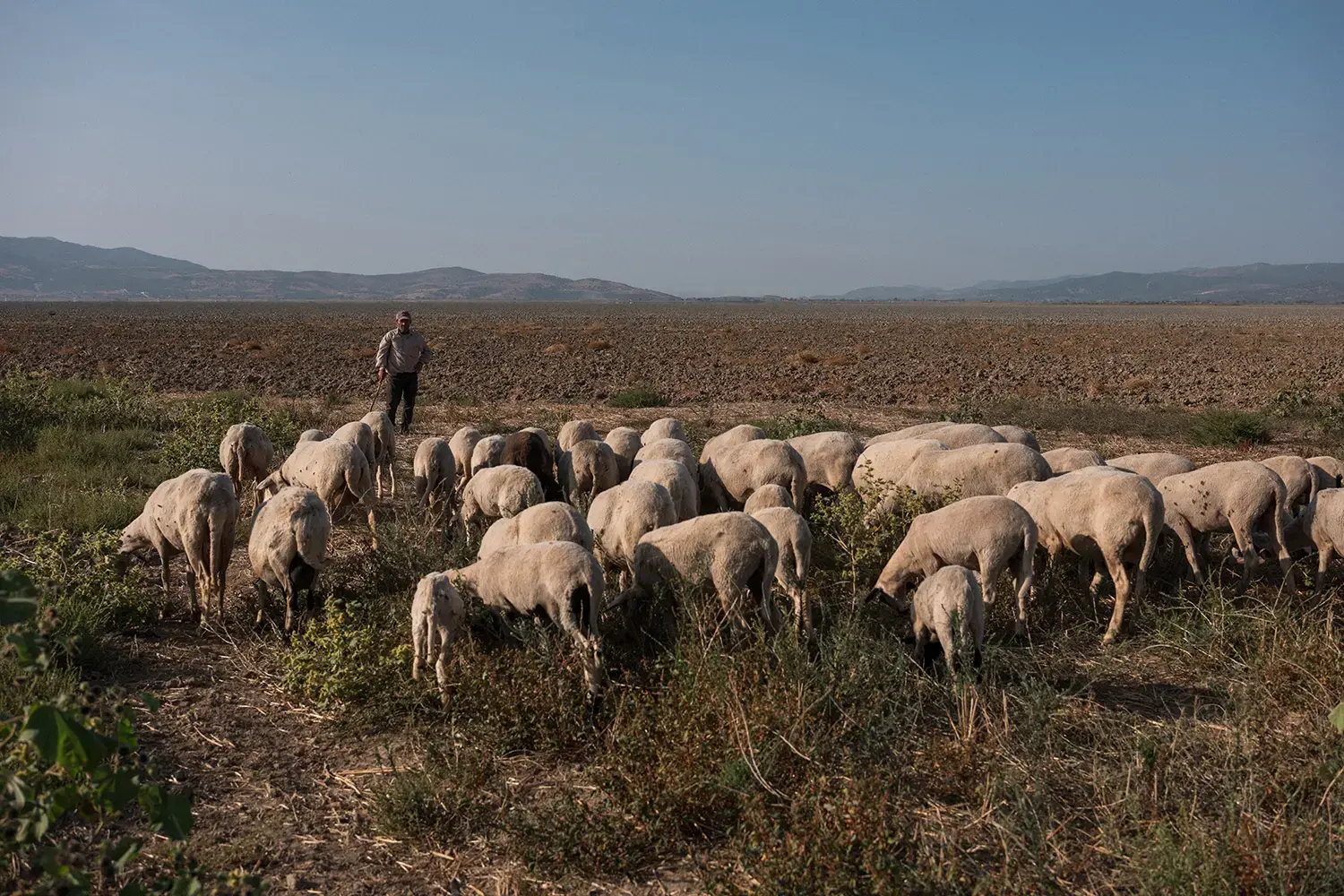
Many European countries, faced with similar problems, are now demolishing old dams and restoring the river and lake ecosystems that they disrupted. But Erdogan, having turned large-scale construction into a pillar of his political power, continues his dam-building spree. In 2017, he pledged to build 1,368 new dams by 2023, leaving almost no river in Turkey undammed.
In November 2022, he opened the Yusufeli Dam, Turkey’s tallest yet, which has already submerged or cut road access to 18 towns and villages. The Melen Dam, which feeds Istanbul, is leaking and exacerbating the city’s water shortage.
The devastating earthquakes in February have raised fears about the integrity of many other dams, and while the State Hydraulic Works agency is now issuing tenders for remedial work, existing tenders for repairs on dams not affected by the earthquake have been canceled due to the country’s ongoing economic crisis. If left unrepaired, these dams are at risk for catastrophic failure—a fate that struck Derna, Libya, in September, claiming thousands of lives.
Now entering his third decade in power, Erdogan’s cycle is apparent. He has purged his party and opponents and funneled billions to his allies in the construction industry through state-funded projects without competitive tenders or proper regulatory oversight. Environmental assessments have been ignored, or not done at all. The companies that built the often-faulty dams have reaped huge profits but faced few consequences for the damage their projects have inflicted. Come election season, Erdogan has used the construction megaprojects on the campaign trail as proof of how far Turkey has come under his leadership.
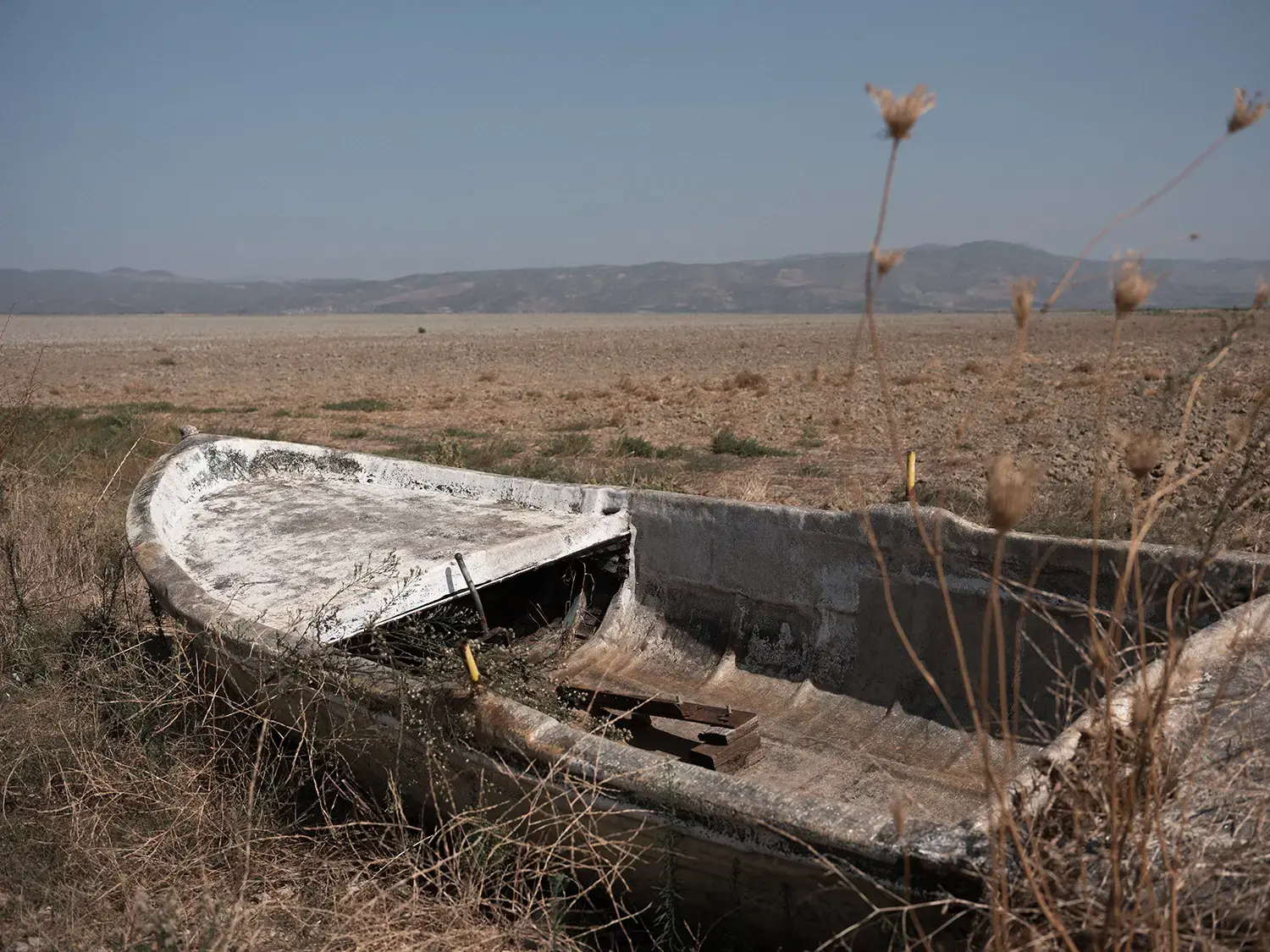
But in Tekelioglu, the dam doesn’t feel like progress. It has destroyed a rich ecosystem and the livelihoods that ecosystem supported. The village’s young men say there is no future in fishing. Instead they are looking to the cities, such as overpopulated Izmir, where there are at least factory jobs. Kazim Efe, 21, looked at his hands as he spoke of his likely future.
“Like the birds, we will migrate too,” he said.















